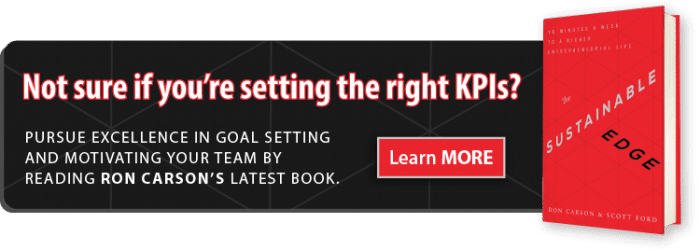Published By: Ron Carson | @rchusker
In business, what gets measured gets done. That is why so many businesses set up key performance indicators (KPIs).
So why did creating sales targets go so wrong for Wells Fargo, bring down CEO John Stumpf and lead to the bank’s $190 million settlement in a suit that accused it of creating up to 2 million credit card and deposit accounts for customers who did not authorize them.
I would argue that the same internal goals meant to drive a company’s growth can, if misused, poison its culture and destroy its brand.
For the most part, using KPIs can be a great way to motivate a team, as I discussed in my recent book The Sustainable Edge. Tracking these goals on a dashboard is a smart way to spur both business units and individual team members to achieve peak performance.
However, KPIs can become dangerous when they bring the wrong focus to a company or a group of internal stakeholders.

Wells Fargo was once envied for its reputation and culture, and the bank worked hard to protect them. As a result, Warren Buffet has been a well-known admirer, and Berkshire Hathaway is still the bank’s largest shareholder. But Wells Fargo’s aggressive sales goals focused on short-term financial targets at the expense of its brand.
Don’t get me wrong. Quarterly financial goals matter. If you don’t stay in business, you can’t serve the people who rely on you for a paycheck or the clients you serve. However, there has to be a healthy balance.
When companies get onto the quarterly earnings treadmill and insist on too high of a profit, they will either gouge the client, fail to take care of their internal stakeholders or both. Ultimately, the constant pressure will demoralize team members and cause a once-vibrant culture to self-destruct. To survive, team members will start to think only of their own survival and not of the mother ship’s.
This risk is strongest at companies that don’t pay employees a salary on which they can sustain themselves. Many of the more than 5,300 employees that Wells Fargo fired were making $12 an hour*. People struggling to make ends meet may feel forced to do things they otherwise wouldn’t do.
But simply paying team members more isn’t the answer. They have to be held accountable for how they are hitting any goals the company has set. If you pay people to achieve a particular KPI but accountability is missing, seemingly small incidents of corner cutting can mushroom into transgressions so egregious they can destroy a brand.
No CEO can tell you if everyone in the company is doing the right thing. What we can do is create a culture where internal stakeholders feel they are working shoulder-to-shoulder to succeed and naturally police each other to protect what they are building.

It looks like Wells Fargo—which earned a profit of $5.6 billion last quarter—will survive this scandal. It just agreed to a $50 million settlement in a class action lawsuit that alleged it had overcharged thousands of homeowners who defaulted on their mortgage loans for appraisals.
However, most companies don’t have the deep pockets to weather situations like these. Now is the time to make sure your firm never has to try—by taking a fresh look at the KPIs you are setting for you team. As Buffet has said, it takes 20 years to build a reputation and five minutes to ruin it.
*Source: NPR, September 2016. https://www.npr.org/sections/thetwo-way/2016/09/26/495454165/ex-wells-fargo-employees-sue-allege-they-were-punished-for-not-breaking-law


